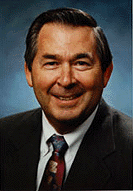
Spring/Summer 1999
Volume 6, Issue 2
Spring/Summer 1998
Volume
3, Issue 1
January 1995
Volume
2, Issue 4
October 1994
Volume
2, Issue 1
January 1994
EAC FOCUS
David M. Cooper
Associate Director of the Computational Directorate, Lawrence Livermore National Laboratory
During his childhood years helping his family "scratch out a living" on a small Texas farm, David M. Cooper was told by his father that education was the key to a more lucrative and fulfilling future. When the Russians launched Sputnik in 1957, Cooper's path became clear.
"I became fascinated with space and decided that I wanted to pursue a career in some way associated with it," he says.
After receiving his B.S. in physics from Texas Technological University in 1962, Cooper embarked on a career at NASA Ames Research Center that spanned more than three decades. He succeeded in accomplishing his educational goals while working as a research scientist in the Hypersonic Free Flight, Lasers and Gas Dynamics, and Computational Chemistry Branches, earning an M.S. in aeronautics and astronautics from Stanford University in 1965 and a Ph.D. in physics from York University in 1974.
In 1990, Cooper was named Deputy of the Aerophysics Directorate at Ames, which consisted of five divisions that covered a wide range of aerospace disciplines. In 1991, Cooper became Chief of the Numerical Aerodynamic Simulation (NAS) Systems Division, where he directed the research, design, development, and operation of high-speed processors, mass storage, high-speed data networks, visualization systems, and support processing equipment. He developed a master system software plan for high performance computing systems, later adopted by the HPCC Program, and was responsible for the technical and management functions of the HPCC Program Testbeds, system software, and advanced algorithm development.
Cooper was promoted to Director of Information Systems in 1994. In this position, he planned and directed the science, technology, development, and operational activities of the Information Systems Directorate. This involved research and advanced technology development in supercomputing and hybrid optical processing hardware and software, network communications, intelligent systems, and human factors. He was responsible for creating NASA's strategic plan for the research and development of pioneering information technologies necessary to revolutionize NASA missions in the next century. In addition, he managed NASA's premiere supercomputing facilities: Ames' Numerical Aerodynamic Simulation and the Office of Aeronautics Consolidated Supercomputing Facilities.
In 1995, Cooper joined Lawrence Livermore National Laboratory (LLNL) as the Associate Director of Computational Directorate, a position he holds today. He provides technical leadership for the development and execution of a broad research and support program in computational science and advanced information technologies. He supervises the operation of LLNL's Accelerated Strategic Computing Initiative (ASCI) computers and problem solving environment that will provide the computational underpinnings for the Science-Based Stockpile Stewardship program. This program, which is operated by the Department of Energy, is designed to meet the challenge of maintaining and certifying the reliability and safety of the nation's nuclear weapon stockpile without underground nuclear testing. He also serves as the Chief Information Officer for LLNL, where he says his greatest challenges are developing an enterprise wide information architecture plan and establishing desktop standards for hardware and software. His current research interests focus on developing tools and computational capability to the point where simulation science replaces the need to perform physical experiments.
Early this year, Cooper was named one of 21 members of President Clinton's Advisory Committee on High Performance Computing and Communications, Information Technology, and the Next Generation Internet, which is co-chaired by CRPC Director Ken Kennedy (see "HPCC Advisory Committee Plans Internet of the Future").
"I think this group has a unique opportunity to chart a course that will keep the U.S. at the forefront of information technologies for the next decade," says Cooper. "I am confident we will be successful."
A member of the CRPC External Advisory Committee since 1995, Cooper says, "My primary role as an advisor of the CRPC is to provide guidance from the customer perspective. I believe that the CRPC should focus on simulation science in the future." Of the center's accomplishments so far, he says, "The CRPC has been extremely successful, largely due to three factors: the center's focus on a needed and timely research area, Ken Kennedy's leadership, and an ever-expanding team of superb people committed to working together on groundbreaking computational research."
Table of Contents
